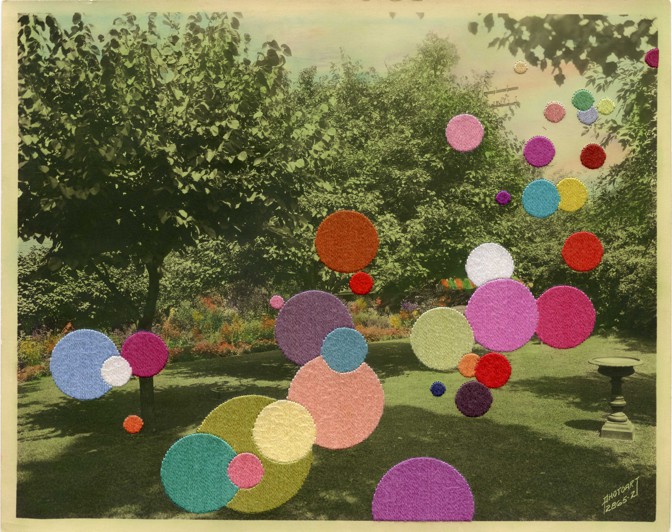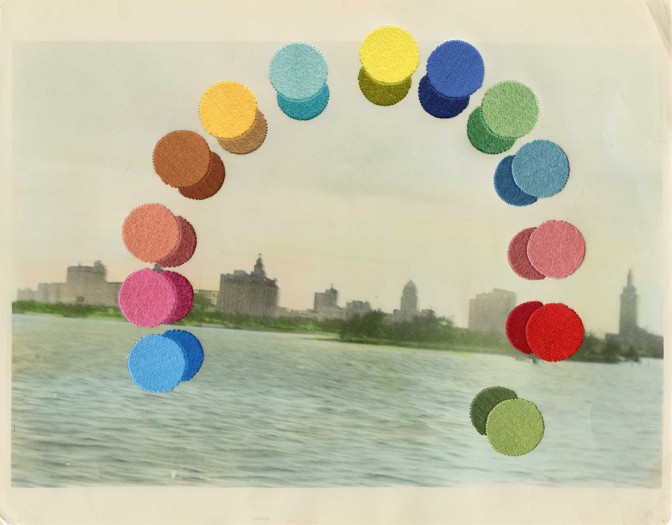My friend Adam Nemett and I became close friends in college, when I basically lived in the house he shared with my then-boyfriend. We saw each other constantly—at home, on campus, over dinner. We got drunk together; took the train to New York City to go clubbing together; emailed during our summer vacations. The last night of college, the three of us wrapped our arms around one another, feeling the weight of this intimacy’s end. This proximity, we knew, would be lost to time and adulthood.
But almost 20 years later, after children (for him) and a divorce (for me), Adam and I have rediscovered a new intimacy. The pandemic has deepened our bond, even though we have abandoned proximity entirely. We keep an almost weekly FaceTime appointment to watch TV together. During those video calls, I see his house and his wife, and he sees my apartment—or, more recently, my friend’s apartment, where I’m crashing because of the divorce. It’s the most time we’ve spent in conversation since we lived together all those years ago. In fact, we’ve never been closer.
[Read: How friendships become closer]
Friendships involve emotional intimacy, but people have assumed that this intimacy is best mediated in space. How many times do we conclude that serious conversations need to happen in person? And yet, exercising a friendship at a distance has been possible for decades—via letters, telephone, text, Facebook, Instagram DMs, and so on. Despite the internet’s ubiquity, those options can still seem like simulacra of friendship, rather than the real thing. Now COVID-19 has made carrying out friendship’s ideal practices hard: house parties; apartment dinners; trips to the park; visits to museums, restaurants, and bars. But the pandemic has also released us from the expectation that closeness requires physical proximity. Instead, it offers an opportunity to decouple good relationships from physical intimacy and to open up other ways for friendships to flourish. Those lessons could improve our relationships now, and later.

The pandemic has narrowed my social circle, but it has also made me more aware of the dynamics of social life. The places I go are fewer, which has limited the people I can see. I used to visit a friend who lived around the corner every day. Now, less often. When I temporarily forget about the pandemic and invite an old friend over, she texts back, “Girl, we have to be outside,” so we meet in the backyard of a coffee shop. Four months ago, I went on a socially distanced, fully masked outdoor park date with my boyfriend (whom I have seen nearly every day since). I miss the ease of just seeing whomever I want, whenever I want—though I’ve also realized how infrequently I used to see my closest friends. The joy of a restaurant dinner has been overwhelmed by the logistics of safety, the concern of exposure. My friendships still form the center of my emotions, but not my physical life. Now they occupy the spatial margins.
This isn’t the first time the way people relate to one another in space has changed. During the Middle Ages and into the Renaissance, many families lived in one room. Collective life and shared intimacies preoccupied culture. Then, things shifted, as the historian John Archer has argued. He sees the early-18th-century adoption of the single-family house as the consequence of Enlightenment values, synthesizing John Locke’s emphasis on selfhood, individuality, and private property. People embraced the “freedom to determine their own selfhood,” Archer writes in Architecture and Suburbia, which “suggested that the material world around us should have a new primacy in defining self.” Individualism caused humans of the modern era to see the physical environment as existing to realize their whims and desires, rather than as a social commons.
Aditya Ghosh, an architect and a writer, told me that what’s happening now—the emphasis on in-between spaces, restaurants taking up streets, finding ourselves in parks and medians, almost hiding our intimacies—is akin to the queering of physical space. “The queer community has always taken advantage of that liminality between planned cities to create a very temporary and performative kind of space,” Ghosh said—to make use of spaces in a social world that did not overtly support their intended behaviors and relationships. Now everyone has to do this, everywhere. He offered the transactional nature of cruising in the gay community as an example. The negotiated clarity of cruising reminds me of how many of us have learned, in the pandemic, to adopt a set of safety rules under an umbrella of shared social responsibility and comfort. We have transactional deals with one another, explicitly codified: who wears a mask, who’s been where, who’s been with whom. It’s like safer sex, except the sex is just breathing.
Using the city this way changes its temporal dimension too. As Ghosh said, “the queering or appropriation of any kind of urban condition is extremely sensitive to time.” In the short term, that means trying not to linger. In the long term, it means an acceptance of the fact that we have no idea how long this state of affairs will last. We will only ever know how long the coronavirus pandemic lasted once it ends.

“What I feel with the lack of space is the lack of pleasure,” Amale Andraos told me when I asked her for her thoughts on friendship and the pandemic. She is the dean of the Graduate School of Architecture, Planning and Preservation at Columbia University and a principal at the design firm WORKac, along with her husband, Dan Wood. Andraos was a colleague of mine before the pandemic but has become a true friend since—a relationship we codified by having a phone call rather than a Zoom meeting: In an age of videoconferences, closeness can now be measured in how free you feel roaming about your own, private space while socializing via technology.
As we spoke, she moved around the garden of her Rhode Island home; I paced my apartment. Sometimes I laid down and sometimes I stood up. I was noticing my environment while listening to her. It was so much more intimate than the times we’d sat across a table from each other to talk about architecture.
[Read: The pandemic is changing work friendships]
The isolation has been hard on Wood, the couple’s client work has been thrown into upheaval, and the demands upon Andraos as an institutional leader have been enormous. “I think this house will be equated with this time of trauma,” she said. She and Wood are redesigning the house completely, making it absolutely open. “We have depended very much on enclosed spaces in order to coexist, and for separate Zoom channels,” Wood told me. “A lot of what we’re doing in the new house is opening it up even more.” It’s a design decision that makes no sense for the needs of the pandemic, and is thus absolutely rooted in believing that this state is temporary: Designing an even-more-connected future habitat makes material their faith that one day the pandemic’s isolation will end, dinner parties will come back, and people will return to offices and restaurants.
I find myself moving in the opposite direction: seeking greater isolation. Recently, I checked myself into a hotel near the World Trade Center so that I could finish a book manuscript. I spent most of the time alone, but not nearly most of it writing. Instead, I took walks to the 9/11 memorial to remind myself that architecture matters. I watched a 1996 Jennifer Aniston movie while texting with my friend Jackie, who was watching the same movie at the same time in Los Angeles. I felt closer to Jackie than usual because I was completely alone in this hotel room, and when I’m completely alone, I feel fully available to others in a way I don’t otherwise. And I felt close to my boyfriend, who came to visit. We walked around SoHo and Nolita together, the first time either of us had spent time in Manhattan since before the pandemic, and I saw the animal drive for closeness play out everywhere, in the hunger I could feel for proximity.
[Read: Friends are breaking up over social distancing]
I’m surprised at how much less lonely I feel now than at any other point in my life. Maybe it’s because I know that everyone else is lonely too. Maybe it’s because I had more practice. Many years ago, I suddenly moved to the desert to get away from mold (or my marriage, depending on how I’m looking at it), and I learned how to be remote friends with everyone I knew. It prepared me for now; it allowed me to see that intimacy didn’t have to be mediated through physical space, or proximity. I adapted, quickly, to the idea that I might never see my friends in person ever again.
The pandemic will end, eventually. Dan Wood will be able to hang out with his friends. Amale Andraos will be able to get off Zoom. I’ll be able to have a coffee with my friend inside. Everything ends, after all. And so might the new, unfamiliar intimacy that we have built, unless we cultivate it.
In one scenario, Adam and I realize how much we like “seeing” each other this frequently, and we make plans to do so even though he has a family in Virginia and I have a partner and a dog in New York. But in another scenario, once the pressure of the pandemic fades and the hunger to connect dissipates, we revert to our once-every-few-years rhythm. I can see a future in which my boyfriend and I cease to marvel at what’s open when we walk around the city and instead regress into frustration at the wait for brunch or the nuisance of the tourists. Today, just getting an ice-cream cone successfully feels like magic. Will it always?
The veneer is already cracking. Tonight, I walked to a restaurant to place a takeout order. A woman complained that her reservation wasn’t being honored, distraught that she’d been asked to wait for 10 minutes (outdoor dining is open in New York City). It felt so normal—and devastating. It made me want to preserve parts of this moment in amber, to remember that we still wanted to be close to one another, even though we couldn’t be. That we longed so profoundly for connection that we tolerated bad internet and a terrible season of Westworld, bending the city to make it meet up again. That even though we couldn’t touch each other, we still felt close. That there are thousands of ways to connect with each other, when we want to, whether we’re close and masked; far and virtual; proximate and counting on the wind.



